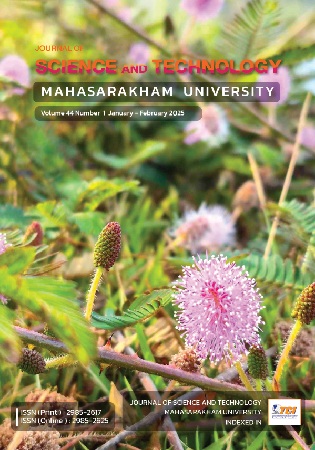Effect of tungsten equivalent on hardness of heat-treated semi-multi–alloyed white cast irons with 0% carbon balance
Main Article Content
Abstract
This study investigates the effect of tungsten equivalent (Weq) on the hardness of heat-treated multi-alloyed white cast iron with a 0% carbon balance. Specimens with Weq values ranging from 6.0 to 8.0% were prepared. The specimens were annealed at 950°C and cooled in the furnace. The annealed specimens were then austenitized at 1050°C and 1100°C, followed by quenching with fan air. After hardening, the specimens were tempered at temperatures between 400°C and 600°C. The results showed that the microstructure consisted of austenite dendrites and eutectics (g+MC) and (g+M2C), with the (g+M2C) eutectics increasing as the Weq values increased. Hardness in the as-hardened state decreased with increasing Weq values. The tempered hardness curve demonstrated secondary hardening due to the precipitation of secondary carbides and the transformation of austenite to martensite. The degree of secondary hardening (DHs) increased with higher Weq values and austenitizing temperatures. The maximum tempered hardness (HTmax) was achieved at a tempering temperature of 500°C in all specimens. The highest HTmax values, 879 HV30 and 848 HV0.1 were obtained in the 6.7% Weq specimen, hardened at 1100°C and tempered at 500°C.
Article Details
References
Boccalini, M. (2011). high speed steels for hot rolling mill rolls. Abrasion Wear Resistant Alloyed White Cast Iron for Rolling and Pulverizing Mills, 123-142.
Chang, W., Pan, Y., Sasaguri, N., & Matsubara, Y., (2008). Effect of C and W content andheat treatment condition on microstructureand wear resistance of multi-componentwhite cast iron. Abrasion Wear Resistant Alloyed White Cast Iron for Rolling and Pulverizing Mills, 35-48.
Hashimoto, M., Kubo, O., & Matsubara, Y. (2004). Analysis of Carbides in Multi-component White Cast Iron for Hot Rolling Mill Rolls. ISIJ International, 44(2), 372-380
Hashimoto, M., Kubo, O., & Matsubara, Y. (2008). Development of multi-component cast iron (HSS) roll and rolling technology in steel rolling. Abrasion Wear Resistant Alloyed White Cast Iron for Rolling and Pulverizing Mills, 1-23.
Hashimoto, M., Kubo, O., & Matsubara, Y. (2011). Effects of Alloying Element on Compressive and Wear Properties of Multi-Component White Cast irons for Steel Rolling Mill Rolls. Abrasion Wear Resistant Alloyed White Cast Iron for Rolling and Pulverizing Mills, 183-192.
Inthidech, S., & Matsubara, Y. (2020). Effects of Carbon Balance and Heat Treatment on Hardness and Volume Fraction of Retained Austenite of Semi-multi-alloyed White Cast Iron. International Journal of Metalcasting, 14(1), 132-143.
Inthidech, S., Yamamoto, K., & Matsubara, Y. (2020). Effect of Tungsten Equivalent on Heat Treatment Behavior of Semi-multi-alloyed White Cast Iron for Abrasive Wear Resistance. International Journal of Metalcasting, 14(1), 1-12.
Khanitnantharak, W., Hashimoto, M., Shimizu, K., Yamamoto, K., Sasaguri, N., & Matsubara, Y. (2009). Effects of Carbon and Heat Treatment on the Hardness and Austenite Content of a Multi-Component White Cast Iron. Transactions of the American Foundrymen's Society, 117, 435-444.
Laird, G., Gundlach, R., & Rohrig, K. (2000). Abrasion-resistant cast iron handbook. American Foundry Society Illinois, 202-203.
Matsubara, Y., & Sasaguri, N. (2002). Heat treatment characteristic of multi-component white cast iron for cold work roll. Abrasion Wear Resistant Alloyed White Cast Iron for Rolling and Pulverizing Mills, 207-216.
Matsubara, Y., Sasaguri, N., Shimizu, K., Sung & Kon Yu. (2001). Solidification and abrasion wear of white cast irons alloyed with 20% carbide forming elements. Wear, 250(1–12), 502–510.
Matsubara, Y., Sasaguri, N., Wu, H.Q., Honda, Y., & Hashimoto, M. (1993). A new material for rolling mill rolls multicomponent white cast iron. Proceedings of the International Symposium on Tribology, 1993 Oct 19-22, Bejing China, 501-510.
Meebupha, T., Inthidech, S., Sricharoenchai, P. & Matsubara Y., (2017). Effect of molybdenum content on heat treatment behavior of multi-alloyed white cast iron. Materials transactions, 58(4), 655-662.
Mitsuo, H., Yasuyuki, N., Nobuya, S., & Yasuhiro, M. (2006). Influence of Carbon andVanadium on Mechanical and Hot Wear Properties of Multi-component White Cast Irons for Steel Rolling Mill Rolls. Journal of Japan Foundry Engineering Society, 78(5), 238–244.
Opapaiboon, J., Sricharoenchai, P., Inthidech, S., & Matsubara, Y., (2015). Effect of carbon content on heat treatment behavior of multi-alloyed white cast iron for abrasive wear resistance. Materials transactions, 56(5), 720-725.
Sasaguri, N., Matsubara, Y., & Hashimoto, M. (1996). Solidification process of multi-component white iron for rolls. Asian Foundry congress (AFC-4), 273-281.
Sinphakdee, P., & Inthidech, S. (2018).Effect of Carbon Balance on Hardness and Retained Austenite of Heat-treated Multi-alloyed White Cast Iron, Proceedings of the The 14th Mahasarakham University Research Conference (MRC#314), Mahasarakham, Thailand 52-60.
Wu, H-Q., Sasaguri, N., & Hashimoto, M. (1994). Solidification Structures and Their Quantitative Analysis of Multi-Component Cast Iron. Asian Foundry Congress (AFC-2), 109-119.
Wu, H-Q., Sasaguri, N., Matsubara, Y., & Hashimoto, M. (1995) Type and morphology of carbides precipitated in multi-component white cast iron. Imono, 67(1), 49-55.
Wu, H-Q., Sasaguri, N., Matsubara, Y., & Hashimoto, M. (1996) Solidification of multi-alloyed white cast iron: type and morphology of carbides. Transactions of the American Foundrymen's Society, 104, 103-108.
Yothathorn, N., & & Inthidech, S. (2018). Effect of Tungsten Equivalent on Hardness of Heat-treated Multi-alloyed White Cast Iron, Proceedings of The 14th Mahasarakham University Research Conference (MRC#314), Mahasarakham, Thailand. 227-235.
Yu, S.-K. (1997). Effects of Carbon Content on Microstructure and Amount of Austenite in As-Cast and Heat-Treated Multi-Component White Cast Iron. Journal of Korea Foundry Society, 17(5), 488-493.
Yuzo, Y., et al., (2010). Influence of molybdenum and tungsten contents on behavior of continuous cooling transformation in multi-component white cast iron. Journal of Japan Foundry Engineering Society, 82(1), 8-15.


